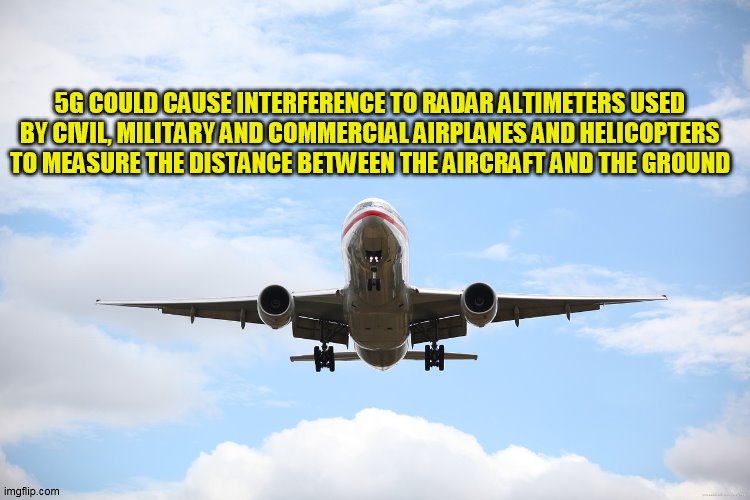 By B.N. Frank
By B.N. Frank
Opposition to 5G deployment is increasing worldwide due to numerous significant issues associated with it. This has limited, slowed, and/or stopped activation in some locations including again recently near U.S. airports due to unresolved aviation risks. The Federal Communications Commission (FCC) is supposed to protect Americans from the telecom industry but has instead catered to it for decades (see 1, 2). This has led to several lawsuits filed against it as well as well-documented complaints made by lawmakers, other government agencies, and consumer, corporate, cybersecurity, environmental, energy, health, and trade organizations. In regard to controversial 5G technology, recently, FCC Chairwoman, Jessica Rosenworcel, said that the agency needs to “rethink our approach to spectrum policy and move beyond just transmitters and consider receivers, too.” Of course, the Consumer Technology Association (CTA) has objected to this so only time will tell if the FCC will actually provide sufficient safeguards on transmitters and/or receivers. Additionally, at least one airlines group maintains that retrofitting airplanes’ altimeters with 5G filters won’t eliminate dangerous interference issues.
From Ars Technica:
FAA: Airlines must retrofit faulty altimeters “as soon as possible”
Altimeter fixes will let AT&T and Verizon fully deploy 5G on C-Band spectrum.
The Federal Aviation Administration says it finally has a plan for the industry to replace or retrofit airplane altimeters that can’t filter out transmissions from outside their allotted frequencies. The altimeter problem has prevented AT&T and Verizon from fully deploying 5G on the C-Band spectrum licenses the wireless carriers purchased for a combined $69 billion.
The FAA was urging airlines to retrofit or replace altimeters in recent months and now says it has finalized a plan. An FAA statement on Friday said that “airlines and other operators of aircraft equipped with the affected radio altimeters must install filters or other enhancements as soon as possible.”
AT&T and Verizon said they will be able to accelerate 5G deployments near airports in the coming months, but the carriers agreed to continue some level of “voluntary mitigations” in the airport areas until July 2023.
Altimeters are used by airplanes to measure altitude. The FAA said a new “phased approach requires operators of regional aircraft with radio altimeters most susceptible to interference to retrofit them with radio frequency filters by the end of 2022. This work has already begun and will continue on an expedited basis.”
Filters can be installed in a few hours
Additionally, “filters and replacement units for the mainline commercial fleet should be available on a schedule that would permit the work to be largely completed by July 2023,” the FAA said, continuing:
The radio-altimeter manufacturers have worked at an unprecedented pace with Embraer, Boeing, Airbus and Mitsubishi Heavy Industries to develop and test filters and installation kits for these aircraft. Customers are receiving the first kits now. In most cases, the kits can be installed in a few hours at airline maintenance facilities.
Throughout this process, the FAA will work with both industries to track the pace of the radio altimeter retrofits while also working with the wireless companies to relax mitigations around key airports in carefully considered phases.
FCC said 220 MHz guard band should be enough
The Federal Communications Commission in February 2020 approved mobile use in the C-Band, specifically from 3.7 to 3.98 GHz. As airplane altimeters rely on a spectrum from 4.2 GHz to 4.4 GHz, this left a 220 MHz guard band to protect altimeters from 5G transmissions.
The FCC found that harmful interference to altimeters was unlikely to occur “under reasonable scenarios” given the size of the guard band and power limits the FCC required for C-Band transmissions. The FCC also urged the aviation industry to conduct more research “on why there may even be a potential for some interference given that well-designed equipment should not ordinarily receive any significant interference (let alone harmful interference) given these circumstances.”
The FAA and aviation industry were nonetheless unprepared for the C-Band launches originally scheduled to begin in December 2021. AT&T and Verizon agreed to a nationwide delay for about six weeks and to limits on deployment near airports until mid-2022. The carriers last week agreed to keep some restrictions near airports in place for another 12 months.
“During initial negotiations in January, the wireless companies offered to keep mitigations in place until July 5, 2022, while they worked with the FAA to better understand the effects of 5G C-band signals on sensitive aviation instruments,” the FAA said Friday. “Based on progress achieved during a series of stakeholder roundtable meetings, the wireless companies offered Friday to continue with some level of voluntary mitigations for another year.”
Carriers are satisfied‚ but airlines object
Verizon said the latest development will let it “make full use of our C-Band spectrum for 5G around airports on an accelerated and defined schedule. Under this agreement reached with the FAA, we will lift the voluntary limitations on our 5G network deployment around airports in a staged approach over the coming months meaning even more consumers and businesses will benefit from the tremendous capabilities of 5G technology.” Verizon said the deal “is the result of months of close collaboration with the FAA, FCC, and aviation industry.”
AT&T said that “close coordination with the FAA over the last several months” has helped the carrier develop “a more tailored approach to controlling signal strength around runways that allows us to activate more towers and increase signal strength.”
“Though our FCC licenses allow us to fully deploy much-needed C-Band spectrum right now, we have chosen in good faith to implement these more tailored precautionary measures so that airlines have additional time to retrofit equipment. We appreciate the FAA’s support of this approach, and we will continue to work with the aviation community as we move toward the expiration of all such voluntary measures by next summer,” AT&T said.
Airlines for America, a trade group that represents the major US airlines, is not so happy. “We have serious concerns that the Federal Aviation Administration (FAA) has placed the burden on the aviation industry to act in a way that would previously be considered, by the FAA itself, to be reckless in the context of design changes to safety-critical avionics,” the group told FAA Acting Administrator Billy Nolen in a letter on Friday. The letter was posted on Twitter by Reuters reporter David Shepardson.
“At today’s FAA roundtable we were told that the vast majority of our fleet (approximately 4,800 aircraft) would need to be retrofitted by July 2023,” Airlines for America also wrote. “Given that the FAA has not even approved solutions nor have manufacturers manufactured these products for most of this fleet, it is not at all clear that carriers can meet what appears to be an arbitrary deadline.” The trade group accused the FAA of “acced[ing] to the demands of the telecommunications companies.”
In Friday’s FAA announcement, Nolen said the compromise is fair. “We believe we have identified a path that will continue to enable aviation and 5G C-band wireless to safely co-exist,” he said. “We appreciate the willingness of Verizon and AT&T to continue this important and productive collaboration with the aviation industry.” Nolen became the acting FAA head in March, after the resignation of Administrator Steve Dickson.
FCC considers crackdown on bad receivers
Airlines for America argued that the 220 MHz guard band isn’t enough because 5G transmissions use “such high power that significant bleed-over to the radio altimeter band is inevitable.” The 220 MHz guard band is really 400 MHz in practice this year because AT&T and Verizon are not yet deploying above 3.8 GHz.
The altimeter design problem goes back decades. “Fundamentally, the problem is a design issue with the aviation industry’s radar altimeters,” Dennis Roberson, who runs a technology consulting firm and is a research professor at Illinois Institute of Technology, told lawmakers during a House subcommittee hearing in February.
When altimeters were designed, “they had very low-power neighbors, i.e., satellites beaming their information to the earth from very distant orbits… This led the early designers of the altimeters to decide they really could ignore their assigned spectrum boundaries, and as a result they allow transmitted energy far outside their band into the receiver,” Roberson explained.
The aviation industry’s slowness in fixing altimeters may lead to the FCC cracking down on bad wireless receivers. In April, the FCC voted unanimously to launch an inquiry into poorly designed wireless devices that receive transmissions from outside their allotted frequencies.
The inquiry could result in new receiver regulations similar to the rules that already require wireless devices to transmit only in their licensed frequencies. “To avoid harmful interference, we typically have rules about how and when transmitters can operate,” FCC Chairwoman Jessica Rosenworcel said at the April meeting. “But wireless communications systems involve transmitters and receivers… so we need to rethink our approach to spectrum policy and move beyond just transmitters and consider receivers, too.”
Verizon and AT&T may be itching to rollout more 5G ASAP, but so far, 5G service has received mostly bad reviews (see 1, 2, 3, 4, 5, 6, 7, 8) even being described just last month as a “complete hot mess.”
Furthermore, since 2017 doctors and scientists have asked for 5G moratoriums on Earth and in space (see 1, 2) and the majority of scientists oppose deployment due to environmental and health risks. In fact, since 2018, there have been reports of people and animals experiencing symptoms and illnesses after it was activated (see 1, 2. 3, 4, 5). In 2019, telecom executives gave U.S. congressional testimony that they had NO independent scientific evidence that 5G is safe. Of course, research has already determined there are health risks associated with 5G exposure as well as exposure to 4G and other sources of wireless Wi-Fi radiation (see 1, 2) and electromagnetic fields (aka “Electrosmog”). And in 2021, a federal court ruled in favor of organizations and petitioners that sued the FCC for NOT adequately protecting Americans from wireless radiation exposure including 5G. Some researchers have also stated that activation may be contributing to COVID-19 infections as well as hundreds of thousands if not millions of bird deaths. But I digress. It seems that aviation risks still may not be able to be resolved with 5G filters which is obviously bad news for airlines and also air travelers.
Activist Post reports regularly about the FCC, 5G, and unsafe technology. For more information visit our archives and the following websites.
- Wireless Information Network
- Americans for Responsible Technology
- Electromagnetic Radiation Safety
- Environmental Health Trust
- Physicians for Safe Technology
- 5G Free
- 5G Information
- Safe Tech International
Become a Patron!
Or support us at SubscribeStar
Donate cryptocurrency HERE
Subscribe to Activist Post for truth, peace, and freedom news. Follow us on SoMee, Telegram, HIVE, Flote, Minds, MeWe, Twitter, Gab, What Really Happened and GETTR.
Provide, Protect and Profit from what’s coming! Get a free issue of Counter Markets today.
